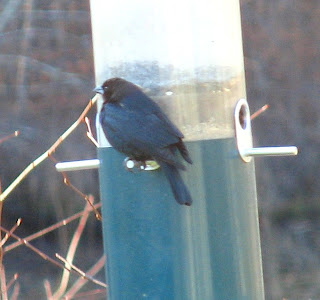Happy New Year! 2012 has arrived, and with it comes a fresh start to the year lists for birders of all ages and experience, and a new year of entering data into
eBird. Since January 2011 I have seen the total checklists and number of regular eBird users jump through the roof in Connecticut. If you are not putting in your bird sightings into the database, well, you may be alone soon!
We get a lot of questions about eBird during bird walks, from visitors, and via email and Twitter. Please feel free to ask for advice and tips, or get help with troubleshooting, whenever possible. For now, I wanted to briefly address something that comes up even with veteran eBird users - the dreaded X. It would be fantastic to
not see any of those entered in the new year.
When entering checklists you put in the number of a given species seen. This can be easy, such as spotting two Black-capped Chickadees at your feeders during the half hour you sat down to watch them and count birds. Putting this sort of data in every day with these exact numbers is as valuable as any other. But let's make it a little more complicated and say you came down to the Connecticut Audubon Society Coastal Center at Milford Point for the day. Maybe you were lucky enough to see a Snowy Owl, whoa! That is an easy count, one bird.
You took a closer look and found some ducks, American Black. You might be able to count them off and come up with 27, or perhaps you noted about 30. That estimate would be fine. Suddenly you see a group of shorebirds go by, Sanderling! There were a whole lot of them, many tens, no - hundreds! You have no idea exactly how many, and who would really know if you saw a group flying by and heading over the Housatonic to Short Beach. So when you go home and enter all of the day's birds into eBird, you will want to check off the species, and many people would do so by using an X instead of a number.
That can be a problem, and it is a relatively easy one I would like to remedy. An X means you might have seen only one Sanderling, and surely that is wrong. It also means you may have spotted 1,487,392 Sanderling - um, I do not think that seems quite right, does it? It can be counterintuitive, but if you are unable to come up with a specific number for a species, or even a close guess to the nearest five or ten, please enter the best number you can. Even if all you could say was that it seemed around 200 birds that would be fine. Maybe the real total was 241 or 173. It is a lot closer than the X is, even if it does not seem like it "making up" a number is better.
While we're on the subject, please try to be exact with your locations, time, and effort, too. Entering data for an entire town has some use, but is much more limited than one list for each of the stops you made each day. Trust me, as someone who enters hundreds or thousands of checklists a year, I know it can get tiring. Keep in mind how much of a contribution you are making to conservation in the state of Connecticut as you are.
Don't forget, if you want to add to those January lists, join us at
Stratford Point for a bird walk on Thursday, January 5.
Scott Kruitbosch
Conservation Technician















